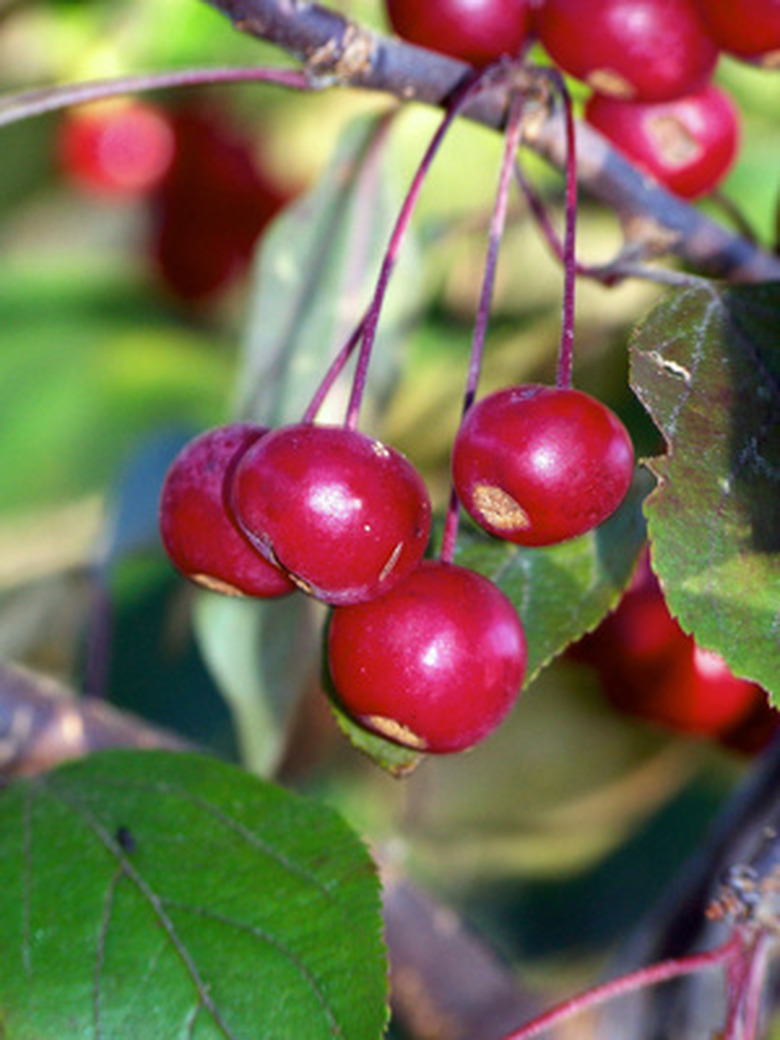How To Transplant Crabapple Trees
Things Needed
- Stem calipers
- Spade
- Surveyor's tape
- Shovel
- Rototiller
- Compost
- Peat moss
- Garden hose
Crabapple trees, a type of ornamental apple tree, are used in the home landscape or as cross-pollinating trees for commercial apple trees. The crabapple is a smaller tree that reaches a size of 15 to 20 feet tall and produces fruit that is less than 2 inches in diameter. Due to the crabapple's smaller size, transplanting the tree is possible even after several years of growth.
Step 1
Root prune your crabapple a year before transplanting. Root pruning helps to reduce the size of the root ball and improves the success of transplanting by encouraging the tree to produce feeder roots within the compact root ball. Estimate the size of your root ball by measuring the tree's trunk with stem calipers at a height 4 feet off of the ground. Multiply the stem inch measurement by 12 to determine the size of the root ball in inches. For example, a trunk that is 2 inches wide will have a root ball that is 24 inches wide.
- Crabapple trees, a type of ornamental apple tree, are used in the home landscape or as cross-pollinating trees for commercial apple trees.
- Due to the crabapple's smaller size, transplanting the tree is possible even after several years of growth.
Step 2
Drive a sharp spade into the soil in a ring around your tree's root ball to cut through roots that extend outside of the tree's root ball dimensions.
Step 3
Mark the tree's north side by tying a surveyor's tape onto a branch on that side. Replant your tree orienting the same way so that the tree will not suffer sunscald.
Step 4
Dig up the tree 1 year after root pruning by inserting a shovel into the ground in a ring 4 inches beyond your root pruning ring. Slip the shovel under the root ball at a depth that is two-thirds as deep as the width of the root ball. Tilt the shovel back to lift the root ball free of the ground.
Step 5
Prepare a planting bed for your tree in its new location by breaking up the soil around the bed with a rototiller to a depth of 12 inches. Spread organic soil amendments such as peat moss and compost over the soil in a 4-inch layer. Mix the amendments into the soil with the rototiller. Amend the soil over a wide range to encourage the tree's roots to develop instead of staying tightly bound in the root ball in a potted plant effect. The planting bed should be located in conditions similar to the tree's original conditions. The tree is already adapted to these conditions and can reestablish itself quickly this way.
- Drive a sharp spade into the soil in a ring around your tree's root ball to cut through roots that extend outside of the tree's root ball dimensions.
- Prepare a planting bed for your tree in its new location by breaking up the soil around the bed with a rototiller to a depth of 12 inches.
Step 6
Dig a hole in the planting bed that is twice as wide as the root ball but no deeper. Place the tree's root ball into the hole and fill in around the sides of the root ball a third of the way with soil. Water the root ball to release air pockets. Fill in around the sides of the roots until the hole is two-thirds of the way full of soil. Water again and then fill the planting hole the rest of the way with soil. Create a soil berm in a ring around the planting hole and water until the berm is filled with water.
Step 7
Water the tree daily for the first two weeks while the tree's roots become established. Then gradually taper off watering until you only water the tree during periods of drought.
- Dig a hole in the planting bed that is twice as wide as the root ball but no deeper.
- Place the tree's root ball into the hole and fill in around the sides of the root ball a third of the way with soil.
Tip
Time transplanting your tree for early spring after all danger of frost has passed. This will give the tree a chance to develop a strong root system before the cold winter weather.
